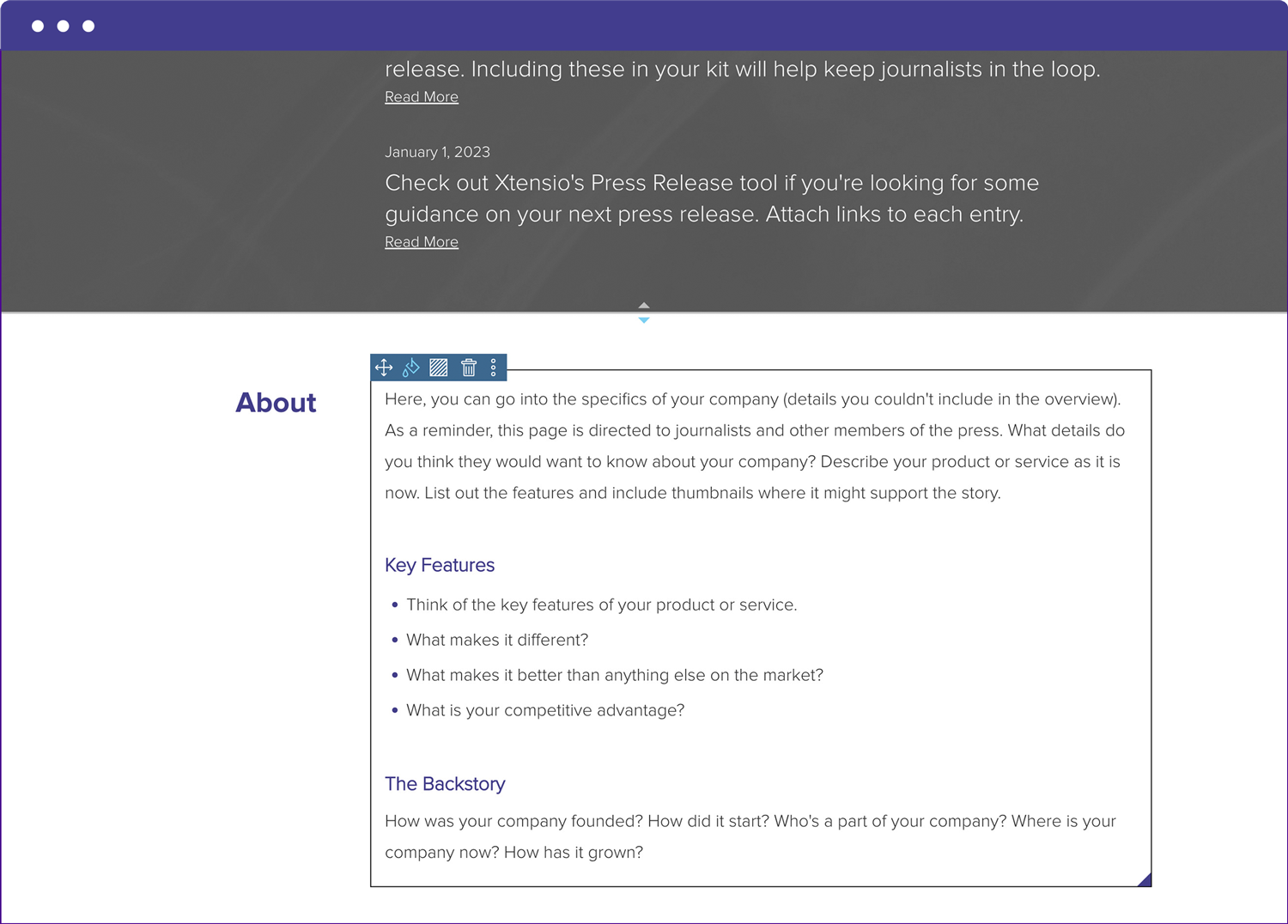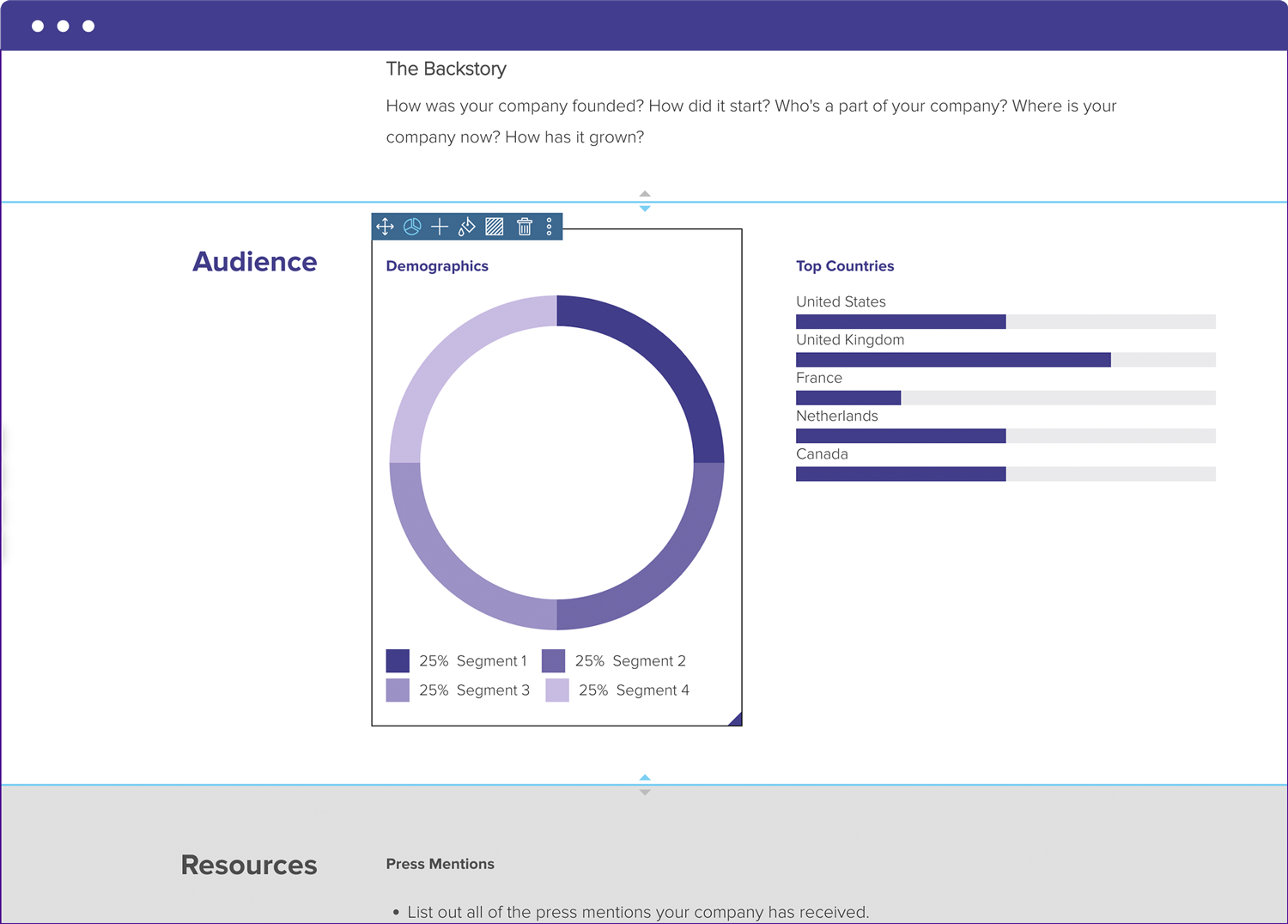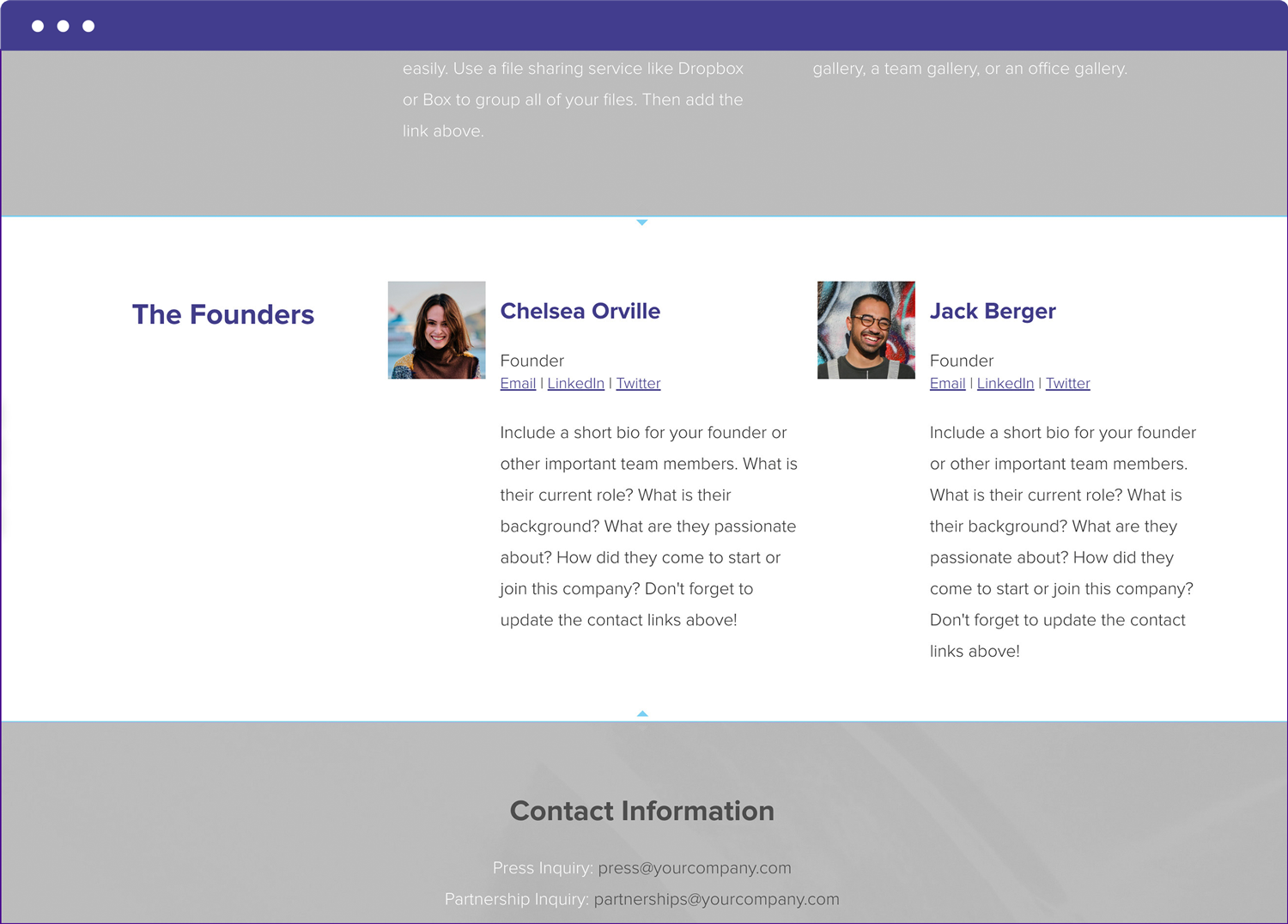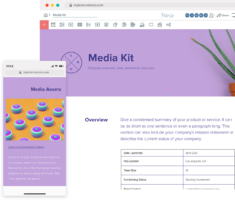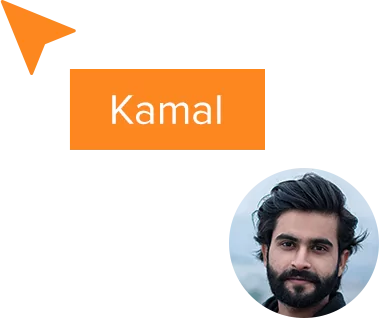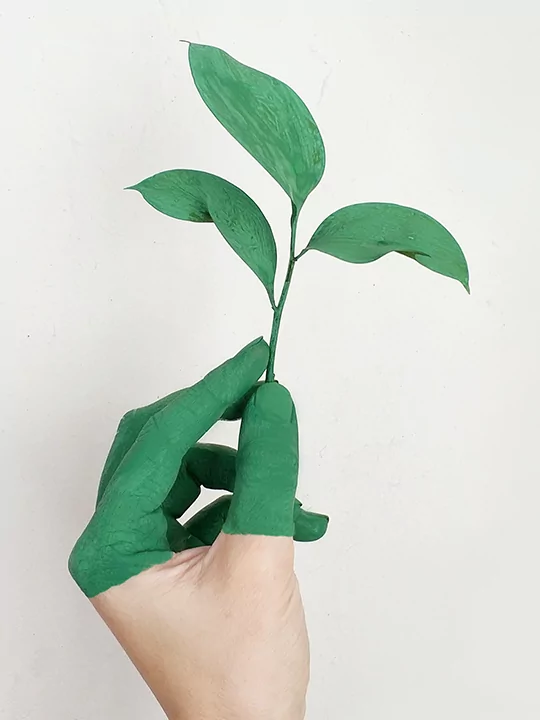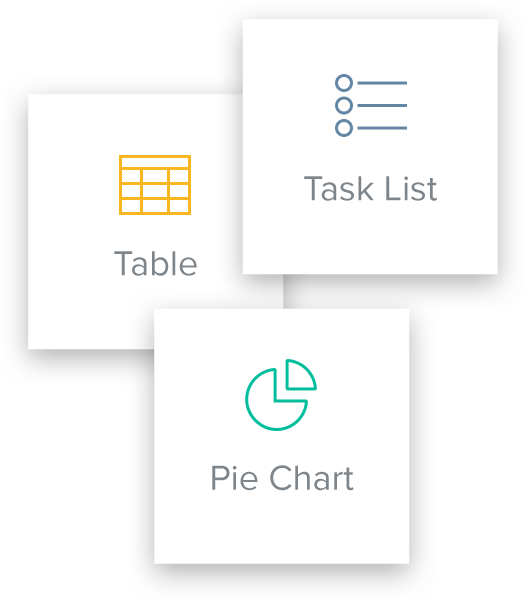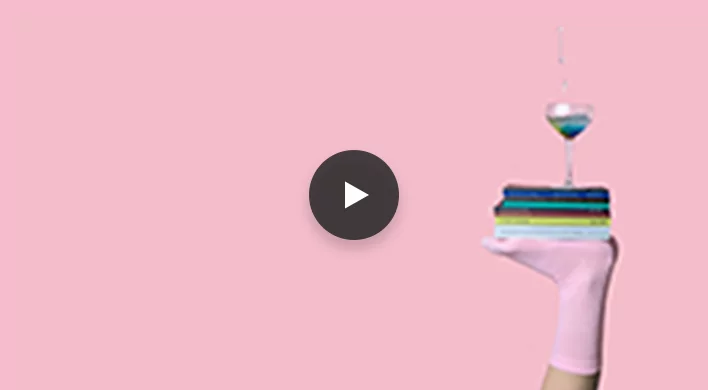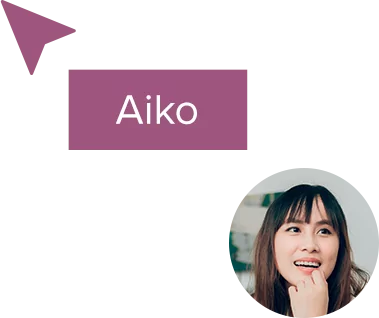How to Make a Media Kit
Updated by Xtensio
A media kit (or press kit) is a document that includes information about your business along with different brand resources which are put together for reporters and media contacts who want to write about your company. Explore this template.
Xtensio is your team space for beautiful living documents.
Create, manage and share business collateral, easily.
Table Of Contents
What is a Media Kit?
Media kits are a package of promotional materials that a business puts together to showcase its brand or services. A media press kit includes information about the company’s background, mission, services, and other statistics, like website traffic, social media followers, and contact information. It’s like a resume of a business that represents who they are and what they offer.
Having a comprehensive media kit is very essential for a brand as it establishes credibility between potential investors or sponsors to work with the company. It keeps everyone on the same page in terms of understanding what the business stand for and what they hope to achieve.
Although a media kit is not a guarantee you will get press coverage, having one will make it a lot easier! Showcase your products, services, and company milestones to professionally present your company’s story to bloggers, podcasters, and even investors.
Online media kit Design and components
Summarize your product or service in a few sentences. You can indicate your company’s mission statement or describe its current status. Some useful information to include in your effective media kit overview:
- Date of launch
- HQ location, company address
- Size of the company, number of team members
- Fundraising status
- Press contact
- Target audience: Indicate who the target audience is, such as journalists, bloggers, or social media influencers.
- Branding: Showcase the company’s branding, including logos, color schemes, and typography, to create a professional look.

Quick Tip: Make sure the contact info is up-to-date. It’s also good practice to have a designated contact email address for press inquiries (e.g. [email protected]).
Press Releases: List a few notable press materials
List your best press release that shows the best achievement of your business. If you have many of them, just mention the important milestones with the most traffic and valuable information about your business history and vision. A good media kit template always shows important information that helps in potential partnerships, so add essential elements like product samples or case studies.

Bonus: If you are looking for an easy way to create beautiful press releases and update them whenever you need, take advantage of Xtensio’s free Press Release template.
About: Highlight additional information
This section of press kits should show the details about your company that weren’t covered in the overview. It is important to know what media coverage you would like to see for your brand, so add the information accordingly. Here is some information that should be covered:
- When was your company founded? A very short background will help the media outlets get an idea of your company’s current stage.
- What are some of the unique features of your product or service? What makes you stand out in your market?
- What is your competitive advantage in the market or your unique value proposition?
Audience: Visualize your market
Who your audience is can be a critical factor in a journalist’s decision to write about your product or service. If your audience naturally fits with their readers, they’ll be more likely to publish content about your company. On the flip side, if their readership doesn’t align with your market, the referral is probably not going to be your ideal customer anyways. That being said, you want to make sure you clearly define and describe your market.
Your connection with the audience is a powerful tool that should not be overlooked. The success of any media outlet and business depends on how well it’s connected with its audience. If your potential customers naturally fit with a journalist’s readers list, they’ll be more likely to publish content about your company. Likewise, if their readership doesn’t align with your market, it will not matter how many people view your company information, the referral is probably not going to work. So for ideal brand deals, clearly define and describe your market with key features of your services and products.

Quick Tip: Avoid unnecessarily long descriptions of your users. Concisely define your audience and visualize your target market with graphs and charts. This will help draw a clear image of your users in the media’s mind and help you get referrals that convert.
Resources: Include all useful materials
When you make a media kit include resources that will help journalists build a story about your company, such as:
- Publications and press mentions. Has your company already received media mentions? Include the post title, writer, and publication name with a hyperlink.
- Quotes. Are there any quotes that would make a difference for the reader? Time to mention them.
- Publication logos. If you have an impressive publication logo and think it will be useful for your media contacts, then you should include this in your media kit resources.
- Media Assets: Provide high-quality images which represent a message about your brand
- Social media platforms: Add social proof so people can reach you easily.
Another important piece of your media kit is high-quality images and assets that tell your brand story. This should include:
- Company logo. If anyone wants to publish about you, they will need your logo to refer to your product or service. Have this ready in all formats that could possibly be required (transparent background and different sizes, brand colors).
- Team or product photos. Images make a powerful statement. Include a recent team photo or showcase a product feature.
Media Assets: Provide high-quality images
Another important piece of your media kit is high-quality images and assets that tell your brand story. This should include:
- Company logo. If anyone wants to publish about you, they will need your logo to refer to your product or service. Have this ready in all formats that could possibly be required (transparent background and different sizes, brand colors).
- Team or product photos. Images make a powerful statement. For marketing purposes, include a recent team photo or showcase a product feature.

Quick Tip: Make sure to add a downloadable media kit. You can use a file-sharing service like Dropbox or Google Drive and add the link to your Media Kit.
Founders: Include a short bio
A high-quality brand story always speaks about the solution your targeted audience needed and emotionally connects with them. So if your business does not have a brand story, it’s time to have one!
Add a quick company history with some key team members that are imperative to the company’s history Give a short biography, and describe their background and how it all started. that people can read and memorize easily. Don’t forget to mention their current role in the company. Add a company’s contact information for direct phone calls. That’s how a deep influencer media kit template should look.

Quick Tip: This is another place you will need to make sure all the contact links are updated! You wouldn’t want to miss a chance to get published simply because of an outdated contact info.
Easily update your media kit
The media kit template is adaptable just like other Xtensio tools. It can and should be repurposed, revisited, and revised to suit your evolving needs. You can duplicate your folio to easily get started on the next one or save it as a template. And remember, all of our templates are meant to be starting points. You can always add, delete, and move your modules and sections around with Xtensio’s versatile editor to adapt the Media kit to your needs. See media kit examples of big companies to get an idea!
What is in a media kit?
A media kit typically contains essential information about a business, product, or individual. It includes a company overview, press releases, high-resolution images, testimonials, case studies, and contact details. It’s a comprehensive package that journalists, influencers, and potential partners use to understand the brand’s story and value proposition.
What is an example of a media kit?
An example of a media kit might be a digital folder containing a company’s latest press release, a founder’s biography, product specifications, high-quality logos and images, recent media coverage, and contact information for the PR department.
What is the best format for a media kit?
The best format is using a flexible living document like Xtensio’s folios: They combine the best of both worlds: PDF for easy sharing and printing and interactive web-based media kits with embedded videos, clickable links, and dynamic content. They are becoming increasingly popular for their versatility and user engagement.
What is an example of a social media kit?
A social media kit is a collection of branded content tailored for social platforms. An example might include profile pictures, cover photos, post templates, and story graphics, all designed consistently with the brand’s visual identity.
How do I create an effective media kit?
Use Xtnsio’s free guide and template and follow along. To create an effective media kit, start by defining your brand’s key messages. Include essential elements like a company overview, high-resolution images, press releases, and contact details. Ensure the design is consistent with your brand identity, and always keep the content updated.
Why is a media kit important?
A media kit is crucial because it provides journalists, influencers, and potential partners with a quick and comprehensive understanding of your brand. It streamlines communication, enhances credibility, and increases the chances of getting favorable media coverage
How often should I update my media kit?
It’s advisable to update your media kit whenever there’s significant news about your company, such as product launches, major partnerships, or notable achievements. At a minimum, review and refresh your media kit annually to ensure all information remains current.
What’s the difference between a media kit and a press kit?
While both terms are often used interchangeably, a media kit is broader and targets a wider audience, including potential advertisers and partners. In contrast, a press kit is specifically designed for journalists and includes press releases, company background, and other newsworthy items.
Can individuals have media kits?
Yes, individuals, especially professionals like artists, authors, influencers, and public figures, often have media kits. These kits highlight their achievements, showcase their work, and provide essential information for potential collaborations or interviews.
How do I distribute my media kit?
You can distribute your media kit both online and offline. Online, host it on your website, and share it via email, or through social media channels. Offline, you can provide printed versions at events, conferences, or during face-to-face meetings. Xtensio’s Media Kit template caters to all these use cases conveniently.



